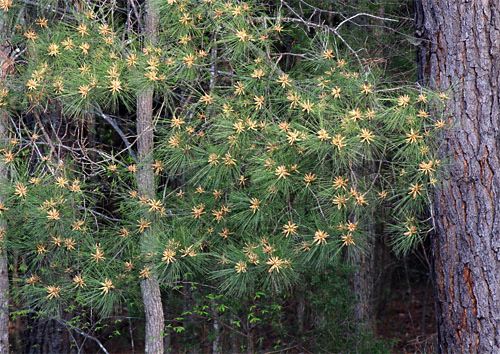|
|
|||
|
(Back to Preceding Week; on to Next Week) |
|
YELLOWBELLY SLIDERS REVISITED:
THE ROAR OF THE TURTLE A few years ago, brother Stan accidentally dug up several live young in a turtle nest while installing fence posts at the old Hilton homestead in Rock Hill SC. We wrote about those little turtlets in April 2004 and included several photos.
All text & photos © Hilton Pond Center Yellowbelly Sliders take the first part of their common name from the bright color of their lower shell (plastron) and the other from a habit that makes them difficult to approach on foot: They're constantly craning their necks to survey their surroundings (above) and at the slightest sign of danger sliding quickly into the water from river banks or floating objects. This makes them notoriously difficult to photograph when on foot, so one must sidle up to them on the water via canoe or hide in a place from which they can be observed. Not having a canoe, we went with the latter alternative and placed our portable photographic blind in a clear area on the Hilton Pond dam--a vantage point formed in part when we cut down a leaning tree that has become the turtles' sunning perch. Our Ultimate Photo Blind (below, from Leonard Rue Enterprises) has holes through which we can stick our telephoto lens, so on several days this week we spent an hour or two inside the camouflaged structure waiting for turtles to pull themselves onto the log. As a reward for our patience, the turtles eventually appeared and we got some splendid close-up views of sliders that otherwise wouldn't have been available in the wild. Unfortunately, glare from lightly overcast skies made it difficult to find a "white balance" and get great photos.
All text & photos © Hilton Pond Center We set up the blind earlier in the week, figuring the turtles might need some time to get used to it; a few mornings later we sneaked up the back side of the dam and entered the blind from the rear. We were a tad clumsy getting in and just the movement of the canvas shooed a couple of basking turtles into the water--we hoped only temporarily. Inside the blind we had previously placed a stool--with cushion, of course--so all that was left was to open our tripod and poke a 100-400mm zoom lens out through the observation port. About 35 minutes later a slider finally appeared, pulling itself onto the low end of the log with its front feet. Although we were at least 20 feet from the log, we tried to minimize movement of the protruding camera lens as we aimed at and focused on the emerging turtle. These so-called "primitive" reptiles have amazingly keen vision, and we weren't about to spook the new arrival. (Fortunately, turtles don't have external ears--we weren't concerned about shutter clicks or other noises--although they are sensitive to vibrations on land and in water.) Despite moderate cloud cover, air temperatures were sufficiently warm and enough UV was coming through to make the turtle's log time worthwhile.
All text & photos © Hilton Pond Center The first Yellowbelly Slider out of the water was an eight-inch-long male (above), which we sexed by the extreme length of his decurved front claws. We can only imagine how much difficulty aquatic turtles probably have getting each others' attention during the mating season, what with their hard top and bottom shells and relatively insensitive scaly skin. (Without external ears or vocal cords, we don't think they're whispering "sweet nothings.") Not to be thwarted in their efforts to procreate, As the male slider got comfortable on the log, he showed characteristic "pajama pants"--prominent stripes on the legs--as well as similar striping on chin and neck (right). These bright yellow markings undoubtedly serve in species recognition and probably even show up underwater if conditions aren't too murky. It's interesting that geographic subpopulations of Yellowbelly Sliders have varying degrees of stripedness; some, for example, have none on their hind legs. Colors fade in older individuals so that a distinctive yellow spot behind the eye often disappears and makes species identification more difficult for human observers.
All text & photos © Hilton Pond Center As we were taking photos of the male slider, a larger, nearly foot-long female hauled herself out of the water onto the log. And how did we know this turtle was a female? Just by noting her front claws were far shorter than those of the male. Plus, when the sexes are side-by-side (or end-to-end, as in the photo below), you can see the male's carapace (top shell) is somewhat flattened, while the female's is more dome-shaped and with more room inside for eggs. On average, mature female Yellowbelly Sliders are about 20% larger than their male counterparts.
All text & photos © Hilton Pond Center As the female turtle came further out of the pond and changed positions on the log, all her hind feet became visible (below). This revealed one of the characteristics of true turtles: Strong webbing between the toes, especially on the rear foot--and just the thing to optimize swimming for an animal that spends the vast majority of its life in the water. Front toes are also webbed, but not as extensively.
All text & photos © Hilton Pond Center By comparison, in purely terrestrial tortoises--e.g., the native Gopher Tortoise, Gopherus polyphemus, or the big Galapagos Tortoises at zoos--there is no toe webbing. Our mainly terrestrial Eastern Box Turtle, Terrapene carolina, is often thought to be a tortoise, but webbing between its hind toes indicates it is really a turtle. We should mention that the rear claws of many female turtles are longer and stouter than those on their front feet--apparently an adaptation that helps when they excavate a nest to lay eggs.
All text & photos © Hilton Pond Center Despite our stealth from within the observation blind, and even though we waited for almost three hours one day, we never got more than two Yellowbelly Sliders at one time on the sunning log--four fewer than the simultaneous sextet we photographed last week from across the pond. Perhaps the blind made the turtles too nervous, or maybe our movements created small vibrations that alarmed them. One turtle "hid" behind a floating stick near the log (above), its mud-stained shell barely visible and with just part of its head out of water. This particular turtle held its position for at least 20 minutes--was it surveying the area for safety?--before slipping back into the depths of Hilton Pond. While it was lurking, however, we noticed something of interest: A dark line, barely visible, cut through its yellow-green eye was always parallel to the surface of the water. After that we started looking more closely at the eyes of other sliders, and found the same to be true.
All text & photos © Hilton Pond Center No matter the angle at which a slider held its head, the dark line was always exactly horizontal--as seen in the photo of a "yawning" female just above. (Despite the title of this photo essay, she's not really roaring.) In fact, when we later looked at more than 200 photos we snapped during three days in the blind, all showed the same phenomenon. We wondered at first whether this was some sort of prismatic illusion that caused the line to appear level, but a Google search turned up a journal article saying the iris line is real and somehow related to a dense horizontal cluster of ganglionic cells in the turtle's retina. Apparently the turtle rotates its eye within the socket so the iris line--and associated retinal line--remain horizontal. We found no clear explanation of why this is important to some turtles; speculation is the line somehow helps a slider adjust to variations in illumination it encounters while exploring its habitat. Those changes are indeed drastic as the turtle goes from feeding areas on dark pond bottoms to the brightly lit surface where a turtle must poke out its head to breathe. Females, in particular, encounter bright sunlight as they wander about on land in search of a place to lay eggs, so it's reasonable they might have an eye adaptation to help handle light variations.
All text & photos © Hilton Pond Center No matter the function of the eye line, egg-laying will be happening fairly soon for our Yellowbelly Sliders at Hilton Pond. Nesting occurs in May and early June and--assuming hungry Raccoons don't interfere--baby turtles will hatch out about two months later. Perhaps by late summer we'll be seeing some hatchlings (above) like those brother Stan dug up back in 2004, each with its yellow neck stripes and horizontal eye line. All text & photos © Hilton Pond Center POSTSCRIPT #1: The sun broke through for a while on 31 March when we were making turtle observations from the blind on the dam at Hilton Pond. As a female Yellowbelly Slider emerged from the water, dozens of tiny insects began landing on her carapace (below).
All text & photos © Hilton Pond Center The insects apparently irritated the turtle, which swatted them away from her face with her forelegs; she also waved her hind legs and pulled them inside the shell. From this behavior we conclude the insects were some sort of biting flies that found softer skin tissue in the gaps between the scales on the turtle's neck and legs. Unfortunately, blowing up the image (below) doesn't provide enough detail to identify the insects, even though we added 1.4x AND 2x teleconverters to our 100-400mm zoom lens. Several entomologists we queried suggested the insects might be members of the Ceratopogonidae, a family that includes biting midges, AKA "no-see-ums" or "punkies," but painful personal experiences in the West Virginia mountains tell us punkies are much smaller than the insects on the turtle.
All text & photos © Hilton Pond Center Female midges need blood for protein to produce eggs; males eat flower nectar. To our knowledge, we do not have any biting midges at Hilton Pond that attack humans (or mammals in general?), so the insects on the turtles may be a large midge species that specifically needs reptiles as blood hosts. We welcome any information folks may have about this whole phenomenon. POSTSCRIPT #2: Last week's photo essay mentioned we were honored when Randy Salas, who writes a "WebSearch" blog for the Minneapolis Star-Tribune, showcased "This Week at Hilton Pond" in his 21 March installment; that particular column also appeared the next day in one of our local papers, The Charlotte Observer, which
All text & photos © Hilton Pond Center
Comments or questions about this week's installment?
Thanks to the following fine folks for recent gifts in support of Hilton Pond Center for Piedmont Natural History and/or Operation RubyThroat: The Hummingbird Project. Your tax-deductible contributions allow us to continue writing, photographing, and sharing "This Week at Hilton Pond."
"This Week at Hilton Pond" is written & photographed You may wish to consult our Index of all nature topics covered since February 2000. You can also use our on-line Hilton Pond Search Engine at the bottom of this page. For a free, non-fattening, on-line subscription to |

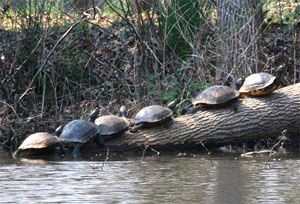 The hatchlings turned out to be Yellowbelly Sliders, Trachemys scripta scripta, a common Piedmont species we also mentioned last week when six adults (right) hauled themselves out of Hilton Pond to sun on a fallen tree--commemorating the arrival of the 2007 spring season. We got several inquiries about our turtle sextet lined up on the log, so this week we're revisiting the topic of Yellowbelly Sliders.
The hatchlings turned out to be Yellowbelly Sliders, Trachemys scripta scripta, a common Piedmont species we also mentioned last week when six adults (right) hauled themselves out of Hilton Pond to sun on a fallen tree--commemorating the arrival of the 2007 spring season. We got several inquiries about our turtle sextet lined up on the log, so this week we're revisiting the topic of Yellowbelly Sliders.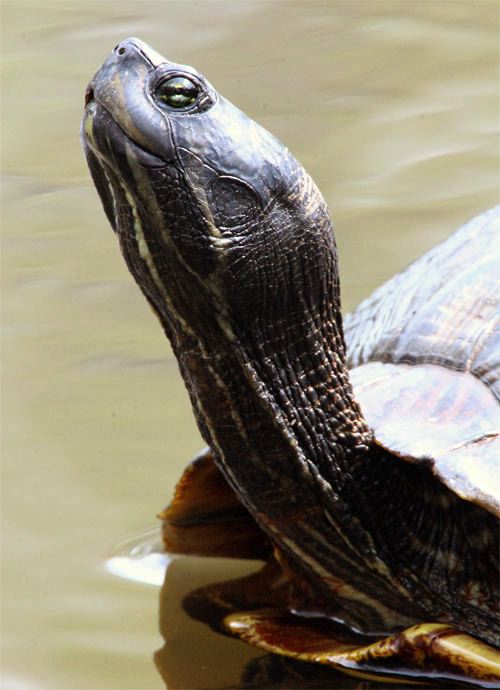
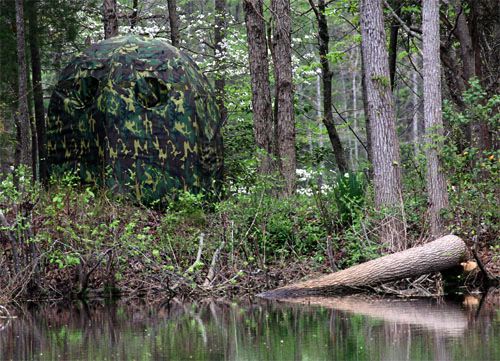
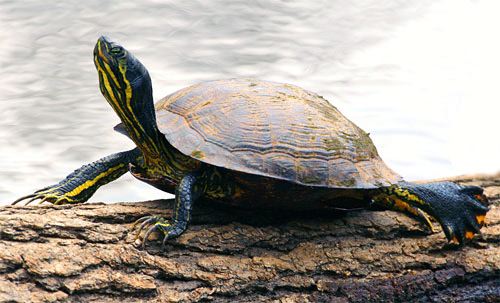
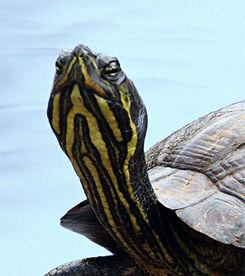 males in several turtle species have longer front claws, the better to provide come-hither strokes across a female's nose. For female turtles this technique is apparently a real turn-on and is just about the only way to get across one's amorous intentions in the cold, dark depths of places like Hilton Pond.
males in several turtle species have longer front claws, the better to provide come-hither strokes across a female's nose. For female turtles this technique is apparently a real turn-on and is just about the only way to get across one's amorous intentions in the cold, dark depths of places like Hilton Pond.

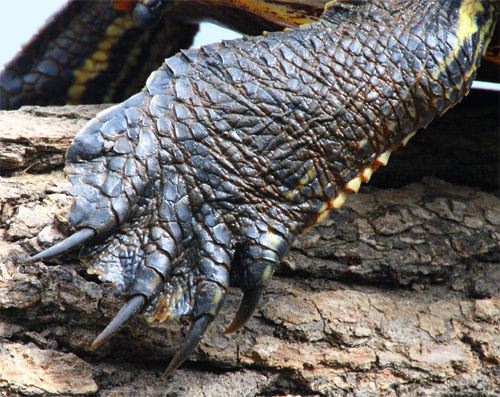


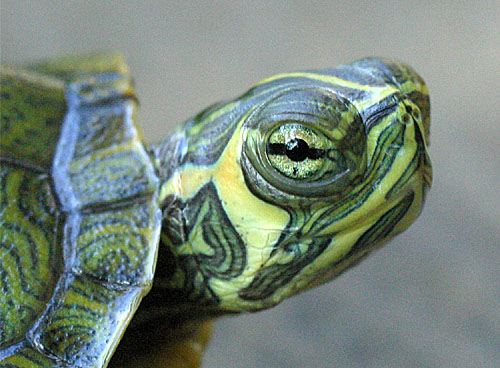
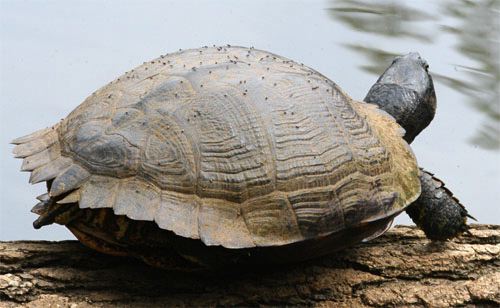
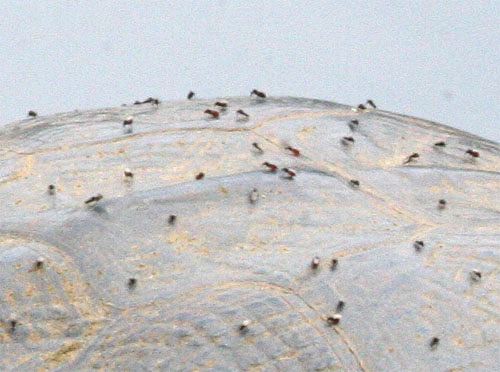
 carries it in syndication. A week later we were pleased and surprised to be reading the 30 March Observer and find that Randy's 28 March compendium of Web sites about birds included our Operation RubyThroat: The Hummingbird Project Web site as an outstanding source for information about hummingbirds. If you're interested in attracting these tiny birds to your backyard--or in learning lots of interesting things about them--please visit
carries it in syndication. A week later we were pleased and surprised to be reading the 30 March Observer and find that Randy's 28 March compendium of Web sites about birds included our Operation RubyThroat: The Hummingbird Project Web site as an outstanding source for information about hummingbirds. If you're interested in attracting these tiny birds to your backyard--or in learning lots of interesting things about them--please visit 

